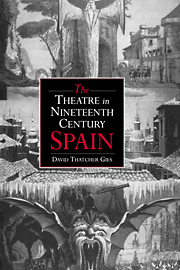Book contents
- Frontmatter
- Contents
- Preface
- Introduction: literary history and canon formation
- 1 Spanish theatre in the nineteenth century. (An overview)
- 2 Theatre and dictatorship: from Napoleon to Fernando VII
- 3 Romanticism and beyond (1834-1849)
- 4 The theatre at mid-century
- 5 “This woman is quite a man!”: women and the theatre (1838-1900)
- 6 High comedy, and low
- 7 Conflicting visions: neo-Romanticism, ridicule, and realism
- Conclusion
- Bibliography
- Index of names
- Index of plays
3 - Romanticism and beyond (1834-1849)
Published online by Cambridge University Press: 07 May 2010
- Frontmatter
- Contents
- Preface
- Introduction: literary history and canon formation
- 1 Spanish theatre in the nineteenth century. (An overview)
- 2 Theatre and dictatorship: from Napoleon to Fernando VII
- 3 Romanticism and beyond (1834-1849)
- 4 The theatre at mid-century
- 5 “This woman is quite a man!”: women and the theatre (1838-1900)
- 6 High comedy, and low
- 7 Conflicting visions: neo-Romanticism, ridicule, and realism
- Conclusion
- Bibliography
- Index of names
- Index of plays
Summary
This is not the place to rehearse the arguments over the origins of the Romantic movement in Spain. Instead, we shall turn immediately to the theatre of the years following the death of Fernando VII in 1833, years generally agreed to encompass the core of Spanish Romanticism. Theatrical activity can be described alternatively or simultaneously as rich and active, or chaotic and fragmented. Performance repertories included translations (some 60 percent as we remember, according to Gassin), comedias de magia, operas, refundiciones, historical dramas, melodramas, neoclassical comedies, comedies of manners, classical tragedies, old-time comedies (cloak and dagger, intrigue, character), and, soon, Romantic dramas. However, Romantic drama cannot be completely understood if separated from what we have been discussing, that is, the complex mix of theatrical performance and spectacle which had been developing since the War of Independence. Romantic drama in Spain did not emerge from a void, nor was it imported from France or England, but rather it grew out of the rich brew of disparate elements which made up the theatre in the first thirty years of the century. As Caldera perceptively notes,
No debe, pues, extrañar que, al lado de las obras de Martinez de la Rosa o del Duque de Rivas, salgan en seguida a la escena madrileña, en algún caso precediéndolas, las de Bretón, Larra, Ochoa, Pacheco, que habian conocido directamente todas las etapas del reinado fernandino. […]
- Type
- Chapter
- Information
- The Theatre in Nineteenth-Century Spain , pp. 96 - 174Publisher: Cambridge University PressPrint publication year: 1994

